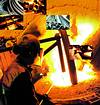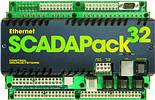

Systems integrator, SCE, recently implemented an environmental monitoring system for Waterval Smelter of Anglo Platinum in Rustenburg.
The ISO 16001 management system of Waterval Smelter in Rustenburg identified emissions to the atmosphere as a significant impact. Accordingly, standard relevant monitoring and management plans must be developed for all significant impacts. A primary step was to be able to control the emission of the SO2, NOX gasses as well as dust before exceeding specified limits, it is important to measure it effectively, reliably and continuously.
System objectives included the need to interface with existing equipment where most of the measurements are implemented. These include interfacing with current loop or voltage loop instruments and serial communication with analysers. The system had to be able to interface with existing PLCs via Ethernet from various plants where plant specific measurements are performed.
The system had to be able to gather data from various monitoring stations in a radius of 30 km around Waterval Smelter site - and all data had to be managed, trended, displayed, reported and integrated with existing data management systems used on site.

ScadaPack controllers were chosen for the new stations interfacing with the existing measuring equipment and for the outstations because of their capabilities: Communication: three or five communication ports, depending on the controller model; Telemetry: software blocks for optimised communication; Data logs: easy to implement data logs offered as standard feature; Expandability: variety of I/O extension boards available with no additional backplanes; Memory: large memory capacity available for programs and data logging; Programmability: ladder as well as IEC-1131 languages available for programming; C programs: controller can execute conventional and C programs simultaneously; Support: local as well as overseas support available; Compact design: small considering the I/O counts; Ease of use: one of the most easy to use controllers available; Reliability: the controllers have three-year parts and labour warranty and only military specification components are used. It carries a Class 1, Division 2 Hazardous area rating.
The ScadaPack controllers and existing PLCs all link up to an iFix scada system. All data on the scada system is made available to the existing Proficy Historian for archiving and trending.
A schematic diagram of the implemented system is shown in Figure 1.

Features of the system
The main stack controller serves as the master and polls the outstations (slaves) one by one every 5 seconds apart via comm1. This interval is more than adequate because the average outstation data for all required measuring points is read by the master in less than one second.
The master ScadaPack controller simultaneously: polls the slave stations via comm1 connected to the radio; reads data from the Fence line station via Ethernet; interfaces with the scada via the Ethernet port; interface with the SMS modem via comm2; at the same time comm3 is used for programming or configuration.
The configurable data logs generated on the ScadaPack controllers are polled from the scada PC with specified intervals. Using the CMI ScadaLog program on this PC, simultaneous upload of realtime and archived logs on the controller are executed. This is accomplished on the same channel and frequency. If a radio should fail, even for a long period, the logs will be read and transferred automatically to the Proficy Historian when the communication is restored. Back dating of data on the Proficy Historian allows for data that was lost due to communication or computer failure, to be recovered.
All ScadaPack controllers can be programmed and/or monitored from any point on the Ethernet network. This includes the controllers for the outstations linked to the main controller via the radio links. The outstations can be programmed while the realtime data gathering is in progress. The main controller can be accessed via the cellphone modem, and all the other stations are accessible via this controller as well.
SMS alarms are sent to applicable personnel to take action. This is accomplished by running a dedicated SMS program developed by SCE on the main stack controller simultaneously with the PLC program.
The system provides expandable PLC front ends that can be used for monitoring and control. Powerful blocks specifically designed for control and telemetry applications are available to optimise communications.
All ScadaPack controllers are backed up by rechargeable batteries to ensure that the system keeps going even with a power failure. The necessary instrumentation personnel are immediately notified via SMS of a power failure.
The advantages of the system
One integrated system: as all data are centrally managed, it can be used to convert data into information, and automate actions based on setpoints and criteria. The central data includes emission data from the process meteorological data collected to monitor emission movement and ambient exposure levels.
Redundancy means that no data on the ScadaPack controllers can be lost due to communication problems, or computer failure. Data is logged on a FIFO moving average basis for roughly two weeks. All data necessary is sent constantly from controllers via the main controller to the scada and Historian. If the communication is restored after having been off for a while, the logged data is retrieved and archived in the Historian automatically.
All controller programming is done in standard PLC language, which makes maintenance and alterations by an administrator instrument technician efficient.
All trends are available over the network via manager nodes and automated daily reports. Configured alarms are sent immediately via SMS messages directly to the person who can take action. The configuration of SMS messages, personnel groups, cellphone numbers, etc, is implemented by means of an easy-to-use utility program.
The total system is a combination of information from existing PLCs, new Ethernet connected stations, radio connected stations as well as optional serially interfaced connections to standalone analysers - all managed on a scada system. A failure of any component of the total system is immediately detectable. The management/auditing of the integrity of the system can be performed by an independent party because there are no 'black boxes' over which control is excluded.
As all information is displayed and archives are trended on the scada system, as opposed to different fragmented islands of information, the information can be managed and controlled better with the necessary controls in place.
After commissioning and testing of the newly implemented system it proved to be in line with the objective. The critical deliverable of a management tool is to the satisfaction of the client and therefore allowing Waterval Smelter to effectively manage one of the most significant environmental impacts of the process. Secondly, because of the realtime nature of the system, immediate action can be taken on environmental management issues, as well as on the maintenance of the integrity of the system.
For more information contact SCE, 012 653 1027, [email protected], www.sce.co.za

© Technews Publishing (Pty) Ltd | All Rights Reserved